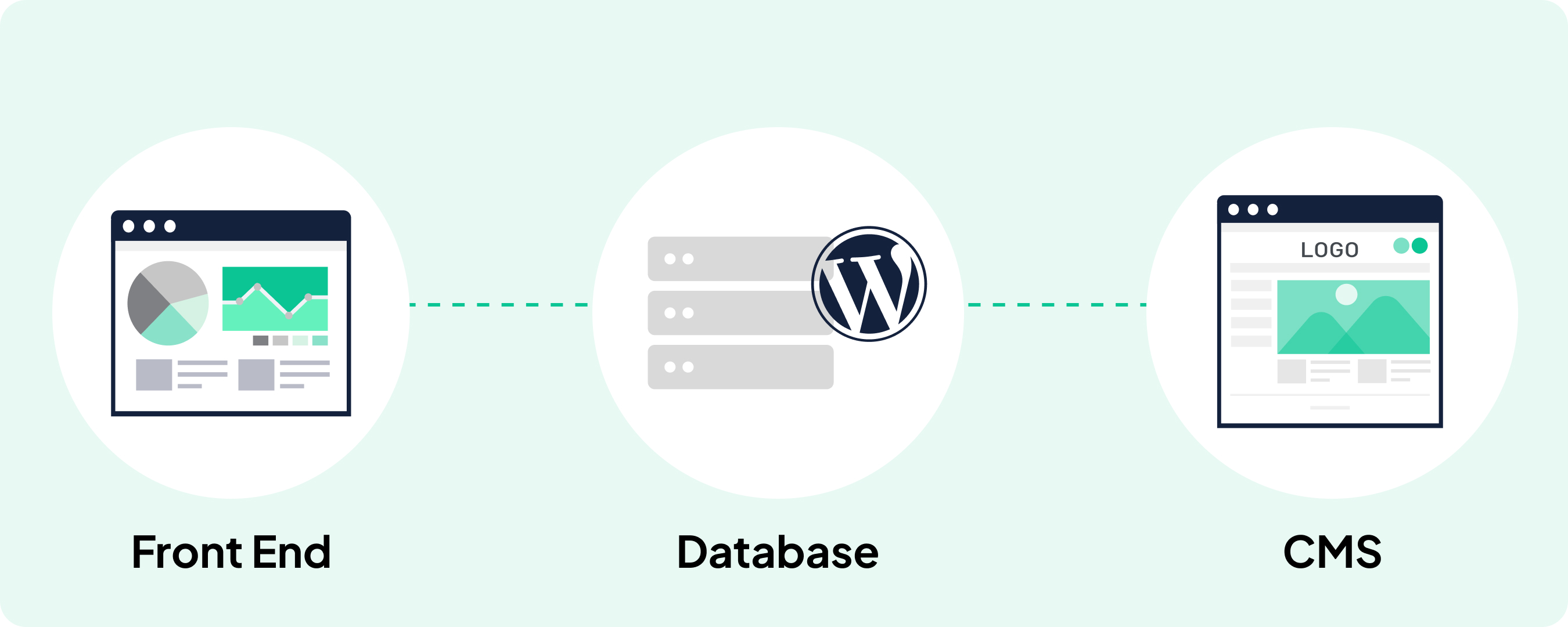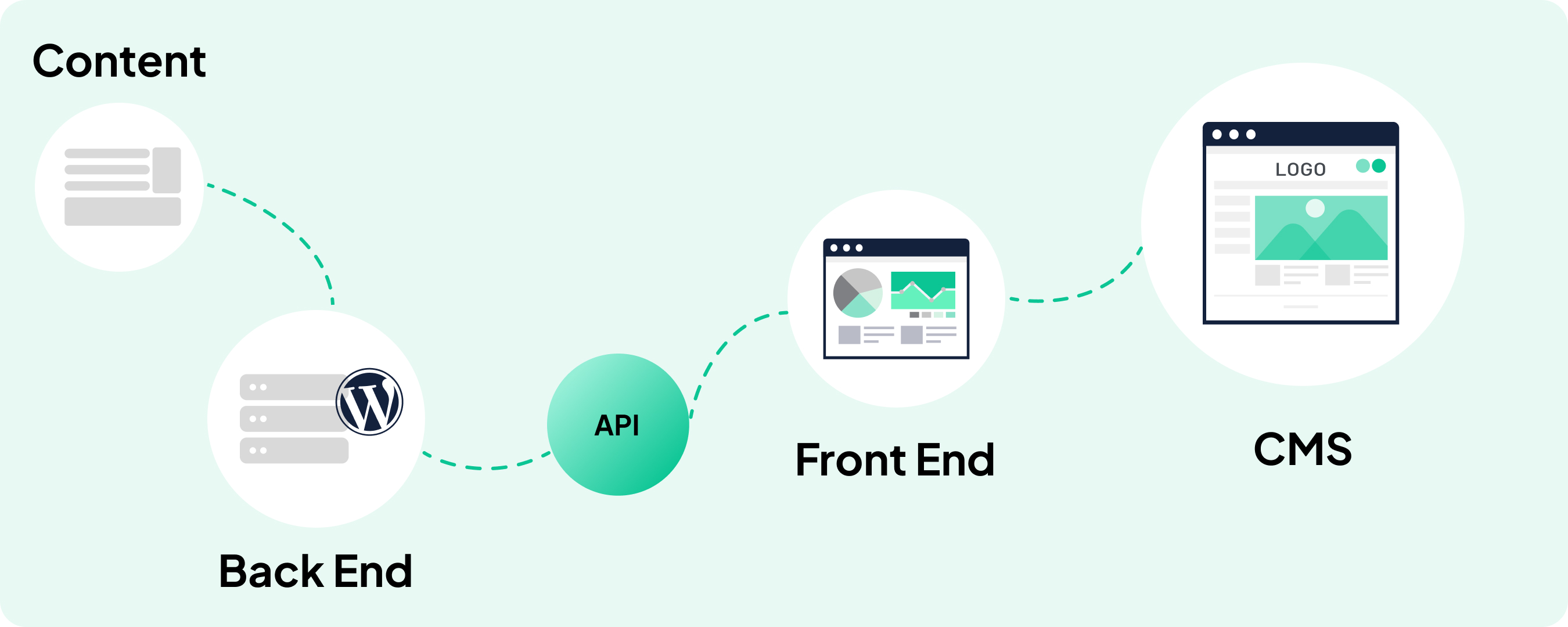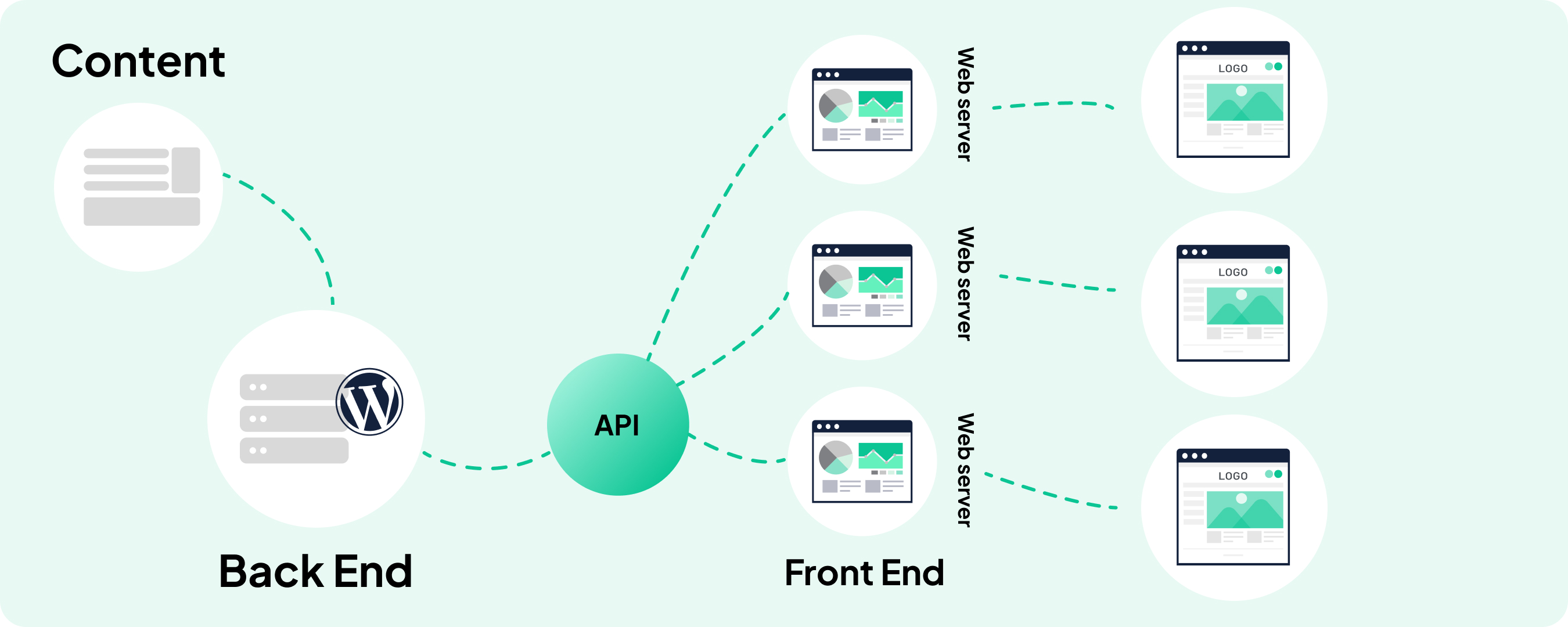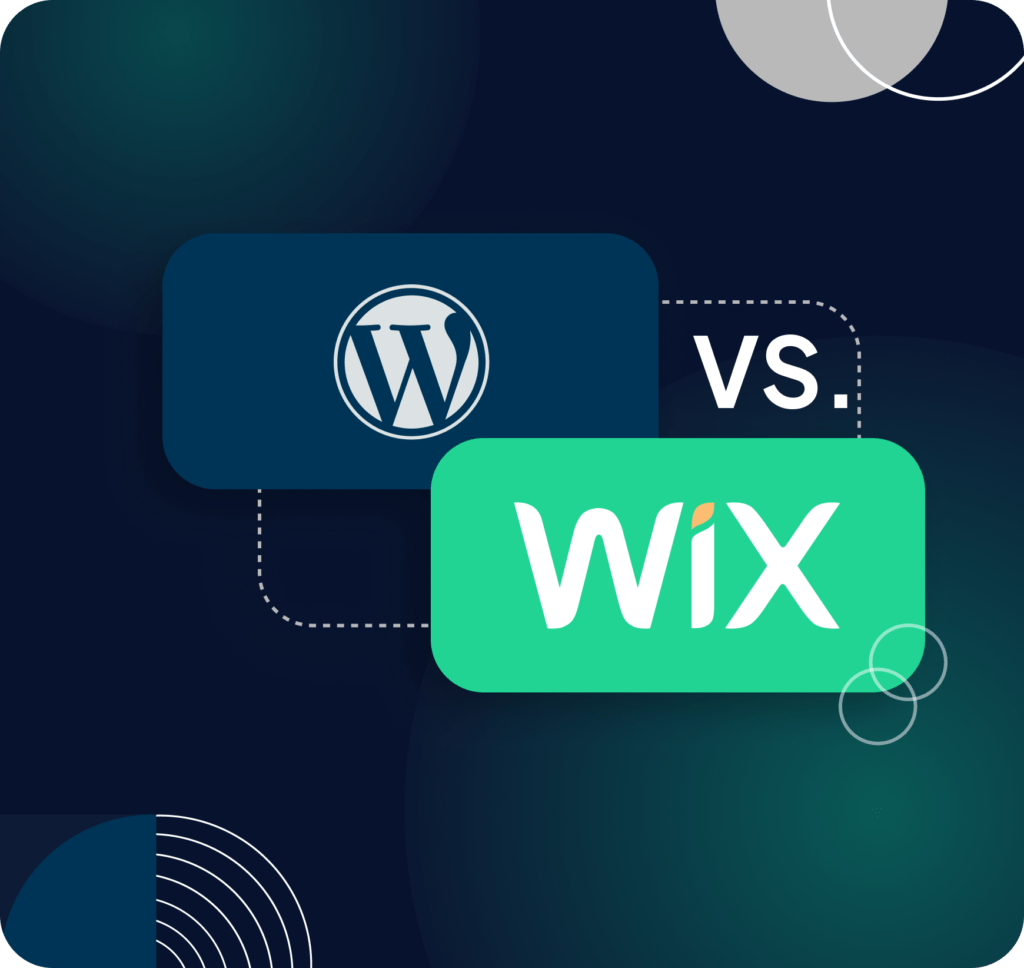Decoupled and Headless WordPress are at the forefront of current WordPress discourse. People are keen to know if these technologies fit their projects well. However, the community needs more clarity on these terms and their implications. People confuse Decoupled WordPress with Headless WordPress, which is two different things.
You must grasp the traditional WordPress architecture. This will help you understand the differences and make informed decisions. Traditional WordPress, or monolithic WordPress, is a single system. It integrates both the frontend and backend. The CMS handles everything. It creates and stores content. It also renders the front end using themes and templates.
The traditional WordPress approach is simple and easy to use, but it has major limitations. Its monolithic nature can harm performance and scalability and limit flexibility. This is a problem for complex projects or those needing modern front-end tech.
In the WordPress vs Headless CMS debate, WordPress is an all-in-one solution. It manages and displays content. A headless CMS separates the backend and frontend. It has more flexibility and scalability. It can deliver content on any platform using modern frameworks like React or Vue.
This article clarifies the concepts of decoupled and headless WordPress, outlines their differences, and indicates when to choose one approach over the other.
Understanding Decoupled and Headless WordPress
In the past, websites consisted of static markup—HTML pages coded by hand and styled with CSS. Visitors would load a page, view the information, click a link, and the browser would reload to display a new page.
The advent of JavaScript changed everything. It lets users interact with page elements and see changes in real-time without a full page reload. It added features like animations, form validations, image sliders, and dropdowns. It made websites feel more interactive.
Is WordPress a headless CMS? Yes, WordPress can operate as a headless CMS, where the backend manages content creation, and the frontend is built using separate technologies like React or Vue. It uses the REST API or GraphQL to deliver content, enabling display on any platform or device.
WordPress and other CMS platforms changed web development. They let content editors input data and auto-generate interactive pages. However, traditional WordPress has limitations. It relies on JavaScript and jQuery for interactivity. Users want fast, app-like experiences. We must move beyond the old server-bound methods of clicking a button and waiting for a response.
Defining Decoupled WordPress
What is a decoupled CMS? A decoupled CMS is a content management system where the content management interface is separated from the user-facing presentation layer. In this setup, the platform where administrators and editors handle content functions independently from the website or application is visible to end users.
In computing, a decoupled architecture is a processor design. It uses a buffer to separate the fetch and decode stages from the execution stage of a program. This design allows components to function without reliance on one another. It allows for differences in structure between the source and target systems.
This architecture improves performance by using a buffer. It isolates memory access from execution. This allows for parallelism. It also reduces the processor’s memory latency. This boosts speed and efficiency.
Decoupled CMS architecture means the front and back end are separate. WordPress handles the backend, where content is managed. The front end uses technologies like React, Angular, or Vue.js. This separation lets developers use modern tools to build dynamic, responsive UIs. The two parts communicate via APIs, often REST or GraphQL. This allows real-time data interaction without reloading the page.
What is a Headless WordPress Site?
In a headless WordPress setup, content resides in a separate database, reducing the security risks typically associated with the frontend. Moreover, headless WordPress makes applying security updates simpler, as the frontend can be updated independently from the backend.
In a headless WordPress setup, WordPress functions solely as a Content Management System (CMS) without providing any front-end output. It handles content creation, storage, and management, while the front end is developed independently using a JavaScript framework or a static site generator. The front end, referred to as the “head,” is entirely detached, giving rise to the term “headless.” This method is particularly effective for creating interactive applications and facilitates content delivery across various platforms, including websites, mobile applications, and Internet of Things (IoT) devices.
Decoupled and headless WordPress models offer greater flexibility and speed. They fix the limits of traditional WordPress setups. Understanding these models shows this.
What about Headless WooCommerce?
WooCommerce headless is changing e-commerce. It combines WooCommerce’s robust backend with a flexible, decoupled frontend using modern frameworks like React or Vue. This approach allows businesses to deliver faster, more engaging user experiences while maintaining easy access to WooCommerce’s features, such as product management and order tracking. Using WooCommerce’s REST API, we can fetch data dynamically. This enables personalized shopping across devices. Headless WooCommerce is perfect for scaling businesses. It offers high performance, customization, and multi-platform integration. It lets developers create unique, high-performing storefronts. They engage customers and adapt to fast-changing market trends.
🔎Know more about how a WordPress website works
Difference Between Decoupled and Headless WordPress
Not all decoupled WordPress setups are headless. But all configurations for headless WordPress decouple.
Decoupled WordPress allows some freedom from PHP limits. It enables selective access to specific WordPress data via APIs. Headless WordPress, on the other hand, separates the backend data from its frontend display. It provides complete independence.
When you think about headless vs decoupled CMS, a headless CMS truly sets content management apart from presentation. A decoupled CMS allows some backend features to influence content presentation, resulting in an integrated and flexible experience.
Decoupled WordPress relies on conventional themes and templates for its front end. Although it maintains a separate back end, content delivery resembles that of standard WordPress configurations. In contrast, Headless WordPress adopts a unique approach by employing modern JavaScript frameworks such as React, Angular, and Vue.js for the front end. This shift enables a more dynamic and interactive user experience.
Flexibility
Decoupled WordPress has limitations in flexibility, relying on WordPress and themes for its front end. This can restrict customization and interactivity. On the other hand, Headless WordPress provides significantly greater flexibility, as the front end is developed independently with custom frameworks. This allows developers to craft highly tailored user interfaces without being constrained by WordPress themes.
Performance
Decoupled WordPress enhances performance by separating the front end from the back end. This division lowers server load and speeds up page loading. However, it still relies on WordPress themes, which may not be as finely tuned as custom solutions. In contrast, headless WordPress offers the promise of even better performance. Headless configurations can provide quicker and more efficient user experiences by employing optimized front-end technologies and minimizing server-side rendering.
Development Complexity
Decoupled WordPress is a breeze for those who know WordPress themes and templates. It makes transitioning from traditional methods feel seamless and straightforward. On the flip side, headless WordPress brings a bit more complexity into the mix. It asks developers to grasp modern front-end frameworks and JavaScript. This can make development more complex, but it opens up powerful possibilities!
SEO and Content Management
WordPress themes are outstanding for SEO and content management within a decoupled setup. The integrated SEO capabilities and plugins collaborate effectively, yielding immediate advantages. In contrast, headless WordPress requires additional configuration to achieve similar SEO performance. Developers must actively apply best practices, a time-consuming process that ultimately leads to a highly tailored and optimized front end.
Benefits of Decoupled WordPress
Improved Performance Through Separation of Concerns
Decoupled WordPress enhances performance by separating the front end from the back end. This division allows each part to be optimized independently, resulting in faster load times and more efficient resource management. By isolating the content management system (CMS) from the presentation layer, developers can focus on optimizing each part for its specific tasks, which leads to improved overall performance.
Easier Transition for Developers Familiar with WordPress Themes
For developers who are well-versed in WordPress themes and templates, transitioning to a decoupled setup is relatively straightforward. The familiar environment of WordPress is retained on the back end, allowing developers to continue using the tools and methodologies they are accustomed to. This ease of transition reduces the learning curve. It accelerates the development process, making it an attractive option for teams looking to enhance performance without completely overhauling their existing workflows.
Access to WordPress Ecosystem, Plugins, and Themes
One of the significant advantages of Decoupled WordPress is the continued access to the extensive WordPress ecosystem. Developers can leverage various plugins and themes available in the WordPress repository. This access ensures that even in a decoupled setup, the rich functionalities and enhancements provided by WordPress plugins can be utilized, offering a robust and feature-rich platform for content management and delivery.
Benefits of Headless WordPress
Enhanced Flexibility and Customization for Front-End Development
One of the most compelling advantages of Headless WordPress is the enhanced flexibility it offers for front-end development. Developers can use cutting-edge JavaScript frameworks such as React, Angular, or Vue.js to create highly interactive and customized user interfaces by decoupling the front end from the back end. This freedom allows for designing bespoke solutions tailored to specific project requirements, free from the constraints of traditional WordPress themes. The ability to build the front end independently means developers can implement the latest web technologies and trends, ensuring that the website remains modern and competitive.
Potential for Superior Performance with Modern Front-End Technologies
Headless WordPress can significantly boost performance by leveraging modern front-end technologies. Content delivery can be optimized headless through static site generation, client-side rendering, and progressive web applications (PWAs). Static site generators like Gatsby or Next.js can pre-render pages during the build process, resulting in lightning-fast load times. Client-side rendering enables dynamic content updates without requiring a full page reload, enhancing the user experience. PWAs offer offline capabilities and app-like performance, making the website more accessible and responsive. These advancements can improve performance compared to traditional WordPress setups, where the server processes each request.
Ability to Use WordPress Purely as a CMS
WordPress is used exclusively as a content management system (CMS) in a headless configuration, focusing on content creation, storage, and management. This separation allows WordPress to excel as a CMS while enabling developers to innovate on the front end. By decoupling content management from content delivery, teams can streamline workflows and improve efficiency. Editors can continue to use the familiar WordPress interface for managing content, while developers can build sophisticated front ends using their preferred technologies. This division of labor maximizes the strengths of WordPress as a robust and user-friendly CMS while providing the flexibility to create unique and high-performance front-end experiences.
Thus, Headless WordPress represents a powerful approach for projects requiring high levels of customization and performance. It offers a blend of innovation and efficiency that can drive better results and user engagement.
Use Cases and Scenarios
When to Use Decoupled WordPress
Decoupled WordPress is a great choice for projects that need better performance. It still uses the familiar structure of WordPress themes. This setup is great for websites that need fast load times and better user experiences. It does this without leaving the traditional WordPress environment. Separating the front and back end lets developers optimize each part. This leads to better performance.
A decoupled architecture enables businesses to transition to an enhanced version of WordPress while retaining its advantages. It boasts a vast ecosystem of plugins and themes, and it continuously incorporates new front-end technologies. This transformation can lessen the learning curve for teams already experienced with WordPress, allowing them to leverage their current skills and tools.
Also, decoupled WordPress is ideal for businesses. It can boost their site’s performance without a complete overhaul. It strikes a balance. It speeds up the front end. It keeps WordPress’s ease of use and flexibility as a CMS. This makes it a suitable option for businesses aiming to improve their website’s efficiency and user experience without significantly disrupting their current workflows.
Headless WordPress examples
Headless WordPress is ideal for projects that require a high level of customization and performance. It allows developers to use modern JavaScript frameworks to create dynamic, interactive interfaces, which provides performance and flexibility benefits. This approach helps build websites, apps, and IoT devices. It makes content available on different platforms. Headless WordPress suits companies that need to integrate their content into complex systems. It uses WordPress only as a CMS to manage content and deliver it via APIs.
Five sites using headless WordPress are: TechCrunch, New York Times Cooking, Big Bite, Harvard Gazette, and Rolling Stone. These sites use WordPress for content and React or Vue for fast, dynamic frontends.
Final thoughts
In summary, Decoupled and Headless WordPress offer distinct advantages. Decoupled WordPress enhances performance while retaining traditional themes, making it ideal for a smoother transition from conventional setups. Headless WordPress, on the other hand, offers greater flexibility and superior performance through modern front-end technologies, using WordPress purely as a CMS.
When choosing between the two, consider your project’s specific needs, such as the level of customization required and the desired user experience. Emerging trends like static site generation and progressive web apps will continue to influence the adoption of decoupled and headless architectures, pushing the boundaries of website performance and interactivity.
At Artilab, we are ready to help you choose the best approach and develop a solution that meets your needs. Contact us, and we will provide high-quality development to increase your website’s efficiency and user satisfaction.







